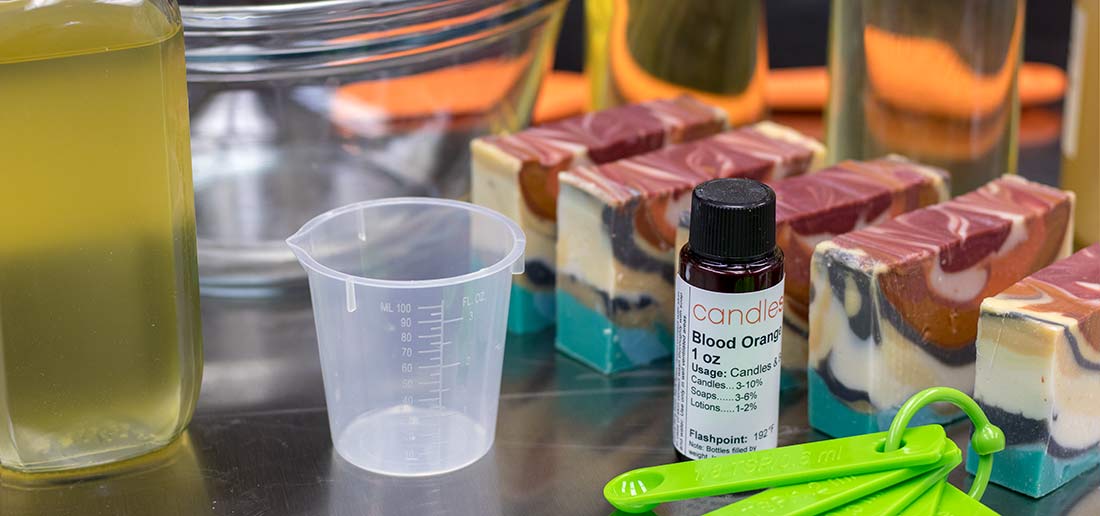Cold Process Soap Fragrance Testing

Crafting high-quality cold process soap requires understanding how various factors, including fragrances, interact with your recipe. To better support our soapmaking community, we’ve refined our testing methods to reflect a broader range of real-world scenarios. While we previously used a slow-moving recipe for testing, we’ve transitioned to an average-moving recipe for a more balanced approach.
As of 2025, we’re reviewing all our soap-safe fragrances using this updated recipe. It will take us time to go through all of our fragrances, so we ask for your patience.
You can find detailed results for each fragrance on its product page. These results are designed to provide helpful insights, but please remember that your own results may vary depending on your specific ingredients, methods, and conditions. We will label any revisions with a testing date on the product page to alert you to what recipe was used for testing.
Below, we outline our updated testing process so you can better understand the context behind our results. Happy soapmaking!
Revised Recipe (2025 and Beyond):
- 40% Olive Oil Pomace
- 25% Coconut Oil (76° Melt Point)
- 15% Mango Seed Butter
- 15% Kokum Butter
- 5% Castor Oil
Saturated : Unsaturated Ratio: 45:55
Our Original Recipe (Pre-2025):
- 5% Castor Oil
- 25% Coconut Oil (92° Melt Point)
- 50% Olive Oil
- 10% Rice Bran Oil (Refined)
- 10% Shea Butter
Saturated : Unsaturated Ratio: 33:64
Our Revised Process
- We test fragrances at 5% unless IFRA requires that we test lower.
- With our revised reciepe, Blended the oils and lye water at 110ºF or lower.
- Used silicone loaf molds and do not cover soap.
- Use a 2:1 water / lye ratio
- Used minimal insulation, typically only two to three molds sitting side by side on a wire rack. This helped us test for overheating and observe if gelling occurred.
We unmolded the soap between 24-72 hours, then cut them. We documented scent strength, changes in odor, and any discoloration. We allowed the bars to cure on a wire rack for four weeks and then checked for scent strength, discoloration, and changes in scent profile.
Pre-2025, we only tested fragrances that were allowed by IFRA in Category 9 at 5% or higher. Going forward, we will test fragrance with an IFRA category as low as 2%.
Before running your own tests, be sure to review the IFRA certificate for maximum usage levels on the product page. Using more or less fragrance may produce different results in your final product.
Once the soaps cured, we saved one bar for reference and donated the others.
Fragrance oils tested:
- Apothecary
- Apricot Grove
- Amber and Driftwood
- Amber Noir
- Apple Harvest
- Autumn Ambrette
- Baltic Dew
- Bamboo and Coconut
- Beach Linen
- Beachwood
- Black Cardamom and Cream
- Black Coral and Moss
- Black Currant and Jasmine
- Black Violet and Saffron
- Brandied Pear
- Brown Sugar and Fig
- Cactus Flower and Jade
- Cake
- Campfire Marshmallow
- Caramel Popcorn
- Caribbean Teakwood
- Cashmere Musk
- Cashmere Plum
- Cashmere Pumpkin
- Cedarwood Blanc
- Cherry Eclipse
- Citron and Mandarin
- Citrus Agave
- Citronella
- Clean Cotton
- Coconut Lime
- Coconut Soleil
- Cranberry Woods
- Creme Brulee
- Cucumber Water and Melon
- Dark Orchard
- Dry Gin and Cypress
- Egyptian Amber
- Elderberry Nectar
- English Garden
- Fig Tree
- Frankincense and Myrrh
- Fraser Fir
- Fresh Linen Odor Eliminator
- Frosted Juniper
- Garden Mint
- Gardenia Tuberose
- Ginger and Spice
- Golden Moon Milk
- Golden Santal
- Grapefruit and Mint
- Green Tea and Lemongrass
- Hibiscus Palm
- High Tide
- Himalayan Bamboo
- Hot Apple Pie
- Jamaica Me Crazy
- Lavender
- Lavender Driftwood
- Lemon Pound Cake
- Library
- Love Spell
- Lychee Blush
- Macintosh Apple
- Magnolia and Peony
- Mahogany Shea
- Mango and Coconut Milk
- Mango and Gardenia
- Maple Leaf and Acorn
- Matcha and Bergamot
- Meadow Thistle
- Mediterranean Fig
- Mistletoe
- Moroccan Cashmere
- Mountain Mist
- Mountain Pine
- Nag Champa
- Neroli and Jasmine
- Nordic Night
- Oakmoss and Amber
- Ocean Breeze
- Orange Blossom
- Orchard Pear
- Passionfruit Pineapple
- Peach Nectar
- Persimmon Citron
- Pineapple Sage
- Pink Sugar Crystals
- Pomegranate Cider
- Pumpkin Pie
- Pumpkin Souffle
- Rain Water
- Rose and Oud
- Rosemary Sage
- Royal Melon Fizz
- Saffron Cedarwood
- Sage and Cypress
- Sandalwood
- Santal and Coconut
- Sea and Stone
- Sea Minerals
- Sea Salt and Orchid
- Seaside Plumeria
- Sel de Mer
- Selanite Glow
- Solar Petals and Tangerine
- Solar Sands
- Sparkling Grapefruit
- Spiced Honey and Tonka
- Spun Cotton
- Starfruit and Kiwi
- Strawberry Guava
- Toasted Coconut
- Tonka and Oud
- Vanilla Cake Pop
- Very Vanilla
- Vetiver
- Volcanic Sand and Sage
- Warm Croissant
- Watermelon
- Watermint and Clementine
- White Birch
- White Copal and Bergamot
- White Currant
- White Oak and Vanilla
- White Sage and Lavender
- White Tea
- Wildberry Mead
- Winter Chalet
- Wisteria Vines
BlendingElement fragrance oils tested:
Essential oils tested:
Essential oils tested at 5% unless otherwise noted.
- Amyris
- Bergamot
- Black Pepper
- Cedarwood (Virginian)
- Cinnamon Leaf 0.85% (max usage rate)
- Clary Sage
- Clove Leaf 2.23% (max usage rate)
- Eucalyptus
- Fir Needle (Siberian) 3.62% (max usage rate)
- Lavender (Bulgarian)
- Lemon
- Litsea Cubeba
- Orange (Sweet)
- Patchouli (Dark)
- Peppermint 1.81% (max usage rate)
- Petitgrain
- Pink Grapefruit
- Tea Tree 1.61% (max usage rate)
- Vetiver (Haitian)
- Ylang Ylang 1.40% (max usage rate)
Have a question?
If you have additional questions please reach out to us at support@candlescience.com.